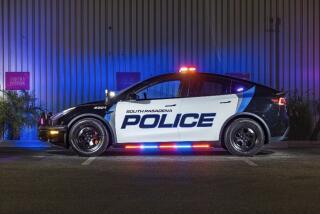Police Bike Team Debuts in Yorba Linda
- Share via
YORBA LINDA — While other kids admired some of the high-tech features of Brea Police Sgt. Bill Vukalich’s bicycle, 4-year-old Matthew Zappia wasn’t impressed.
“Nah. I like motorcycles better,” the boy said.
That drew a laugh from Vukalich and a mild rebuke from the boy’s father, Steve Zappia, himself a Brea police officer. But Matthew’s older brother, Michael, opined that a police officer riding a bike is “cool”--an impression the other children shared.
“This is the greatest public relations work the police have done in years,” said Vukalich, a 20-year veteran of the force. “This has put us in direct contact with the people.”
Brea, which provides police services to Yorba Linda, unveiled its bike patrol Saturday in that city. As hundreds lined the streets for the city’s 25th Fiesta Days Parade, a six-man bike team rode at the head of the parade, waving to the crowd and drawing cheers in return.
As part of the effort to put police officers closer to the people, cities nationwide, including seven in Orange County, have put patrol officers on bicycles. The practice was started by the Seattle Police Department in 1987.
A study by the Brea Police Department found that bike-riding police officers appear less intimidating than those in patrol cars.
“It has become easier for us to approach and talk to people,” said Sgt. Garry Drlik,who helped conduct the study before approval of the program by the Brea City Council in September. “With the growing popularity of bike riding, people relate to us better.”
Currently, the bike patrol has 12 members, divided into two teams, who work on Fridays and Saturdays. With the holiday season approaching, the bike patrol has been assigned to malls, special events and special police operations.
Funding comes from the city’s share of seized drug assets. Recently, the City Council approved a police request for $15,000 to buy the bike team’s equipment, including six bicycles.
Drlik said improved community relations is the bike patrol’s principal goal, although the cyclist cops have also given police flexibility in law enforcement.
“It’s amazing. We are still the same police officers. Nothing changed, except the equipment, yet people appear friendlier,” Drlik said.
Children, particularly, appear to like it the most.
Jason Berezney and Aubrey Linder, both 11, said they like the idea of police officers riding bikes.
“It’s easier for kids to talk to officers on bikes. They are not scary,” Linder, a fifth-grader, said. “They also teach kids to wear helmets” when riding bicycles.
Officers on bike patrol wear dark blue shorts and golf shirts, helmets, gloves and sunglasses. For protection, they wear bulletproof vests, radios with lapel microphones, batons and side arms with nylon gun belts.
Vukalich, 49, the oldest member of the team, said officers must be in good physical condition to stay with the team. He said the team undergoes monthly training, which includes riding on soft sand and jumping over curbs.
He said curb-jumping is necessary in going after fleeing suspects. “It would slow us down if we have to get down off our bikes,” he said.
The ability to go after suspects on the run gives the bike patrol an advantage over officers in patrol cars or on foot. “We have better flexibility. We can cover a wider area faster than if we were on foot,” Vukalich said.
More to Read
Sign up for Essential California
The most important California stories and recommendations in your inbox every morning.
You may occasionally receive promotional content from the Los Angeles Times.













